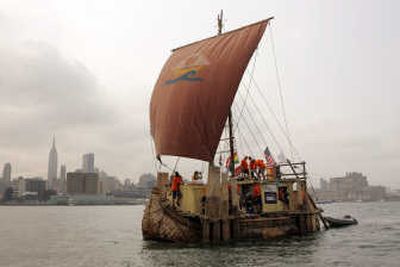Sailor attempts to cross Atlantic with eye on past

NEW YORK – A 41-foot raft made of reeds and wooden planks set out Wednesday on voyage from New York to Spain, a daring and perhaps foolhardy attempt to prove people in the Stone Age could have crossed the Atlantic.
The fragile-looking craft was towed down the harbor past the Statue of Liberty, to be cut loose once it passed into the open sea. At the helm was Dominique Gorlitz, 41, a German botanist and ex-teacher who has spent years preparing for the expedition.
“We are trying to retrace the ancient waterways to prove that prehistoric people crossed the ocean both ways,” Gorlitz said as the Abora III, named for a Canary Island sun god, cast off.
He estimated the voyage would take five weeks to Pontevedra, Spain, where success would prove that mariners predating Columbus by 12,000 years could have navigated the ocean by sailing against – as well as with – prevailing winds. The Abora III will use leeboards to steer like a modern sailboat. A stop was planned at the Azores.
Gorlitz’s crew of 10 men and two women have enough food for 100 days, fresh water and a few modern amenities – satellite phones, navigational gear and generator-powered laptops.
Gorlitz’s theory is based on traces of tobacco and coca – substances native to the New World – having been found in an Egyptian pharaoh’s tomb, as well as cave drawings in Spain he says suggest that people 14,000 years ago understood ocean currents.
Kenneth L. Feder, an anthropology professor at Central Connecticut State University in New Britain, Conn., said Abora III’s trip cannot prove any of that.
“I wish them well, but for a proper replicative experiment in archaeology, the culture has to be consistent,” he said in a telephone interview. “How can they replicate the past accurately by using evidence from thousands of years ago in Egypt and a boat similar to those built 800 years ago in South America? These are completely different periods.”
He said there were other possible ways for nicotine and coca to have turned up – possibly from now-unknown plants in Africa, or even from “mummy unwrapping parties” in 19th century England.
“This trip proves that if you are brave and foolhardy you can sail a primitive boat across the Atlantic, but that’s all it proves,” Feder said.